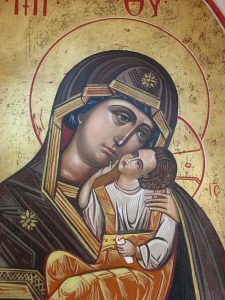 The Orthodox church recognizes as authoritative the decisions of the seven ecumenical councils that met between 325 and 787 and defined the basic doctrines on the TRINITY and the INCARNATION. In later centuries Orthodox councils also made doctrinal definitions on GRACE (1341, 1351) and took a stand in reference to Western teachings. The Orthodox church accepts the early traditions of Christianity, including the same sacraments as the Roman Catholic church–although in the Orthodox church infants receive the Eucharist and confirmation–and the episcopate and the priesthood, understood in the light of APOSTOLIC SUCCESSION. Married men may become priests, but bishops and monks may not marry. The veneration of MARY, as Mother of God is central to Orthodox worship, and the intercession of saints is emphasized in the Orthodox liturgical tradition. After an early controversy on the subject, the images, or ICONS, of Christ, the Virgin Mary, and the saints are now seen as visible witnesses to the fact that God has taken human flesh in the person of Jesus. The LITURGY used by the Orthodox church is known as the Byzantine rite. It has been translated from Greek into many languages, including the Old Church Slavonic used by the Russian Orthodox church. The liturgy is always sung, and communion is distributed to the congregation in both kinds (bread and wine). MONASTICISM, which had its origins in the Christian East (Egypt, Syria, Cappadocia), has since been considered in the Orthodox church as a prophetic ministry of men and women, showing through their mode of life the action of the Holy Spirit. The monastic republic of Mount ATHOS, Greece, is still viewed among Orthodox Christians as a center of spiritual vitality.
The Orthodox church recognizes as authoritative the decisions of the seven ecumenical councils that met between 325 and 787 and defined the basic doctrines on the TRINITY and the INCARNATION. In later centuries Orthodox councils also made doctrinal definitions on GRACE (1341, 1351) and took a stand in reference to Western teachings. The Orthodox church accepts the early traditions of Christianity, including the same sacraments as the Roman Catholic church–although in the Orthodox church infants receive the Eucharist and confirmation–and the episcopate and the priesthood, understood in the light of APOSTOLIC SUCCESSION. Married men may become priests, but bishops and monks may not marry. The veneration of MARY, as Mother of God is central to Orthodox worship, and the intercession of saints is emphasized in the Orthodox liturgical tradition. After an early controversy on the subject, the images, or ICONS, of Christ, the Virgin Mary, and the saints are now seen as visible witnesses to the fact that God has taken human flesh in the person of Jesus. The LITURGY used by the Orthodox church is known as the Byzantine rite. It has been translated from Greek into many languages, including the Old Church Slavonic used by the Russian Orthodox church. The liturgy is always sung, and communion is distributed to the congregation in both kinds (bread and wine). MONASTICISM, which had its origins in the Christian East (Egypt, Syria, Cappadocia), has since been considered in the Orthodox church as a prophetic ministry of men and women, showing through their mode of life the action of the Holy Spirit. The monastic republic of Mount ATHOS, Greece, is still viewed among Orthodox Christians as a center of spiritual vitality.
The Orthodox church has been generally quite open to the contemporary ECUMENICAL MOVEMENT. One by one, the autocephalous churches have all joined the Protestant-initiated WORLD COUNCIL OF CHURCHES, without modifying their own view on Christian unity, but considering the council as an acceptable forum for dialogue and cooperation with other Christians. The recent steps taken by the Roman Catholic church and the decrees of the Second Vatican Council were seen by the Orthodox as promising groundwork for the future, and this positive reaction was witnessed by several meetings between Orthodox and Catholic leaders, including participation by Vatican representatives in ceremonies marking the thousandth anniversary of Russian Christianity in 1988.
Adapted from: John Meyendorff. The Orthodox Church. The Academic American Encyclopedia (Electronic Version), copyright © 1993 Grolier, Inc., Danbury, CT.